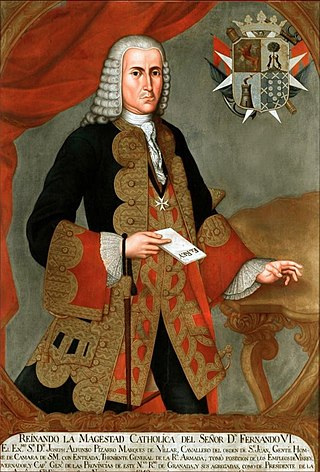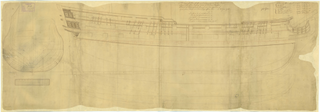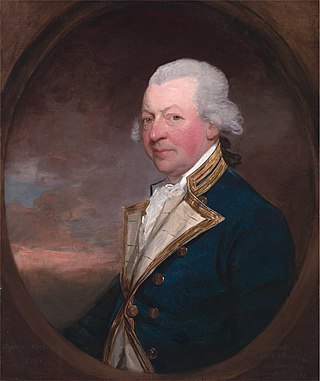
The Battle of Cape St. Vincent was a naval battle that took place off the southern coast of Portugal on 16 January 1780 during the American Revolutionary War. A British fleet under Admiral Sir George Rodney defeated a Spanish squadron under Don Juan de Lángara. The battle is sometimes referred to as the Moonlight Battle because it was unusual for naval battles in the Age of Sail to take place at night. It was also the first major naval victory for the British over their European enemies in the war and proved the value of copper-sheathing the hulls of warships.

Admiral George Carnegie, 6th Earl of Northesk was born the son of David Carnegie, 4th Earl of Northesk and Lady Margaret Wemyss on 2 August 1716. A career naval officer, he fought in the War of the Austrian Succession and the First Carnatic War, where in the East Indies he participated in the action of 6 July 1746. His service was curtailed by a series of debilitating illnesses and he never served at sea again after being promoted to rear-admiral in 1756. He died on 20 January 1792 at age 75.

Santísima Trinidad was a Spanish first-rate ship of the line with 112 guns. This was increased in 1795–96 to 130 guns by closing in the spar deck between the quarterdeck and forecastle, and to 136 guns around 1802, thus creating what was in effect a continuous fourth gundeck although the extra guns added were actually relatively small. She was the heaviest-armed ship in the world when rebuilt, and bore the most guns of any ship of the line outfitted in the Age of Sail.

The Battle of Cape Passaro, also known as Battle of Avola or Battle of Syracuse, was a major naval battle fought on 11 August 1718 between a fleet of the British Royal Navy under Admiral Sir George Byng and a fleet of the Spanish Navy under Rear-Admiral Antonio de Gaztañeta. It was fought off Cape Passaro, in the southern tip of the island of Sicily of which Spain had occupied. Spain and Britain were at peace, but Britain was already committed to supporting the ambitions of the Emperor Charles VI in southern Italy.

José Alfonso Pizarro, Marquis del Villar was a Spanish naval officer and colonial administrator. From November 6, 1749 to November 24, 1753 he was viceroy of the Spanish Viceroyalty of New Granada.

Oriflamme was a 56-gun ship of the line of the French Navy. She was ordered on 16 February 1743 and built at Toulon Dockyard by engineer-constructor Pierre-Blaise Coulomb, and launched on 30 October 1744. She carried 24 x 18-pounder guns on her lower deck, 26 x 8-pounder guns on her upper deck, and 6 x 4-pounder guns on her quarterdeck. The ship was named for the oriflamme, a long, multi-tailed red banner that was historically the battle standard of the Capetian dynasty.

HMS Orford was a 70-gun third rate ship of the line of the Royal Navy, built to the draught specified by the 1745 Establishment at Woolwich Dockyard, and launched in 1749.

John MacBride was a British officer of the Royal Navy and a politician who saw service during the Seven Years' War, the American War of Independence and the French Revolutionary Wars, eventually rising to the rank of Admiral of the Blue.

The Assault on Cádiz was a part of a protracted naval blockade of the Spanish port of Cádiz by the Royal Navy, which comprised the siege and the shelling of the city as well as an amphibious assault on the port itself from June to July 1797. After the battle of Cape Saint Vincent the British fleet led by Lord Jervis and Sir Horatio Nelson had appeared in the Gulf of Cádiz. In the first days of June the city was bombarded, causing slight damage to the Spanish batteries, navy and city. Nelson's objective was to force the Spanish admiral Jose Mazarredo to leave the harbour with the Spanish fleet. The Spanish response was to build gunboats and small ships to protect the entrance of the harbour from the British. By early July, after a series of failed attacks led by Rear Admiral Nelson, and with the British ships taking huge fire from the Spanish forts and batteries, the British withdrew and the siege was lifted. The naval blockade, however, lasted until 1802.

The voyage of the Glorioso involved four naval engagements fought in 1747 during the War of the Austrian Succession between the Spanish 70-gun ship of the line Glorioso and several British squadrons of ships of the line and frigates which tried to capture it. The Glorioso, carrying four million silver dollars from the Americas, was able to repel two British attacks off the Azores and Cape Finisterre, successfully landing her cargo at the port of Corcubión, Spain.

The action of 25 January 1797 was a minor naval battle of the French Revolutionary Wars, fought in the Gulf of Cádiz. The Spanish third-rate ship of the line San Francisco de Asís was attacked and pursued for several hours by a British squadron of three fifth-rates frigates and a sixth-rate corvette under George Stewart, 8th Earl of Galloway. After an intermittent but fierce exchange of fire, the British warships, badly damaged, were eventually forced to withdraw. The San Francisco de Asís, which suffered only minor damage, was able to return to Cádiz without difficulties. The commander of the ship, Captain Alonso de Torres y Guerra, was promoted for his success.

The action of 7 April 1800 was a minor naval engagement fought between a British squadron blockading the Spanish naval base of Cádiz and a convoy of 13 Spanish merchant vessels escorted by three frigates, bound for the Spanish colonies in the Americas. The blockade squadron consisted of the ships of the line HMS Leviathan and HMS Swiftsure and the frigate HMS Emerald, commanded by Rear-Admiral John Thomas Duckworth on Leviathan. The Spanish convoy sailed from Cádiz on 3 April 1800 and encountered Duckworth's squadron two days later. The Spanish attempted to escape; Emerald succeeded in capturing one ship early on 6 April. The British captured a brig the following morning and the British squadron divided in pursuit of the remainder.
Samuel Granston Goodall was an officer of the Royal Navy who saw service during the Seven Years' War, the American War of Independence and the French Revolutionary Wars in a career that spanned 50 years, rising to the rank of Admiral of the White.

Vice-Admiral Charles Stewart was an officer of the Royal Navy who saw service during the Nine Years' War, and the Wars of the Spanish Succession, Quadruple Alliance and Austrian Succession. He embarked on a political career, and was a Member of Parliament for the Parliaments of Ireland and Great Britain.

Lord George Graham was a Scottish officer of the Royal Navy who saw service during the War of the Austrian Succession. He embarked on a political career, and was a Member of Parliament.

Sir Charles Saxton, 1st Baronet was an officer of the Royal Navy who saw service during the War of the Austrian Succession, the Seven Years' War, the American War of Independence and the French Revolutionary and Napoleonic Wars, rising to the rank of captain.
The San Esteban Apedreado was a fifth-rate frigate in the Spanish navy that ran ashore and was damaged in the Rio de la Plata in 1741 and was broken up in 1744 or 1745.
Rear-Admiral George Murray, 6th Lord Elibank was a British naval officer. He joined the Royal Navy in the early 1720s and fought in the Battle of Porto Bello in 1739 as a lieutenant on board the ship of the line HMS Hampton Court. Murray was promoted to commander in 1740 and given command of the sloop HMS Tryall to take part in George Anson's voyage around the world. A series of illnesses and deaths in Anson's squadron meant that by early 1741 Murray had been promoted to post captain and given command of the frigate HMS Pearl. Pearl and another ship lost contact with Anson in April of that year and after taking heavy damage and casualties through storms and sickness, sought safety in Rio de Janeiro before sailing for England.

Rear-Admiral Sir Thomas Hardy was a Royal Navy officer of the late 17th and early 18th centuries. Having joined the navy sometime before 1688, Hardy's career was supported by Captain George Churchill, whom he served as first lieutenant during the Battle of Barfleur in 1692. Promoted to captain in 1693, Hardy served in the Channel Islands and off the coast of England until 1702 when he was given command of HMS Pembroke off the coast of Spain. He fought at the Battle of Cádiz, and subsequently discovered the location of the Franco-Spanish fleet through the intervention of his chaplain, which resulted in the Battle of Vigo Bay. Hardy was knighted for his services.















